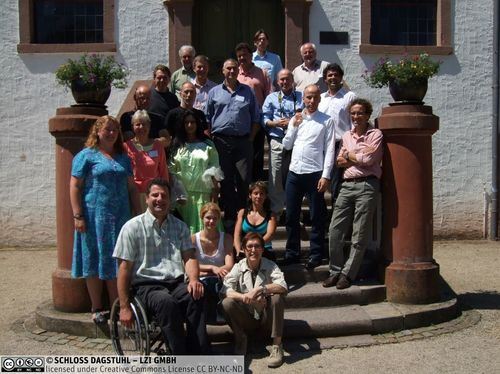Dagstuhl-Seminar 08292
The Study of Visual Aesthetics in Human-Computer Interaction
( 13. Jul – 16. Jul, 2008 )
Permalink
Organisatoren
- Marc Hassenzahl (Universitöt Koblenz - Landau, DE)
- Gitte Lindgaard (Carleton University - Ottawa, CA)
- Axel Platz (Siemens AG - München, DE)
- Noam Tractinsky (Ben Gurion University - Beer Sheva, IL)
Kontakt
Presse/News
Press Reviews
-
Wie macht man -schöne- Technik?
Interview Wolfgang Back vom Computerclub Zwei mit Prof. Dr. Marc Hassenzahl, Universität Koblenz-Landau; Folge 119, 28.07.08 - Download der Sendung 119, 32 Kbit/s (~7 MB)
This seminar intended “to gather a group of about 25-30 participants who will exchange ideas, views, and case study results that address the seminar's themes.” We aimed at discussing methodologies and measures in the study of visual aesthetics in HCI, to explore design antecedents of aesthetic interactive systems, as well as consequences of aesthetic design or aesthetic experience in HCI. We anticipated that the outcome of the seminar “will contribute to clarifying the concept, provide an overview of existing practical resources such as measurement scales, solidify the body of knowledge in this area, and generally spark interest in aesthetics in the HCI community.”
21 people participated in the seminar. This seminar explored various aspects of the study of visual aesthetics in human-computer interaction (HCI). The growing attention that this field is gaining from the HCI community is manifested by the increasing rate of published-, and in-progress research, and by the emphasis espoused by usability- and Usability Experience (UX) practitioners on the importance aesthetic design.
We identified a set of research challenges that this emerging field needs to discuss. These can be broadly classified into four categories, which can be depicted as belonging to two major axes. The first deals with theory building vs. measurement. It includes the development of theoretical and conceptual foundations of the field on the one hand, and the identification and development of measures and research methods that are appropriate for studying it on the other hand. The second axis contrasts antecedents of aesthetic design with its consequences. The context of the aesthetic experience and the contingencies that affect reactions to aesthetic interactive products and applications fall between those two axes.
One of the seminar’s goals was to collect examples and case studies of visual aesthetics in interactive systems. Some participants have discussed the implications of aesthetics for the design of interactive systems and demonstrated the applications of aesthetic principles to design (Löwgren). Fishwick places aesthetics within the context of ubiquitous computing. He demonstrated the application of aesthetics to software representation (e.g., in Second Life) with the ultimate intent of popularizing software engineering.
The seminar concluded with discussions of research topics that need to be addressed further. These include the following:
- Considering visual aesthetics as a dynamic process:
- Considering the transition of computing from an interaction paradigm to the computing-as-medium paradigm and the consequences of such a transition (Nake).
- The educational implications of the importance of visual aesthetics in HCI (Sutcliffe). Only very few in the HCI community are “visual designers”. Who will teach aesthetics to most of the community and how (educational programs)?
- Is the aesthetic experience and resulting evaluation cognitive or emotional? Perceptual and sensory or reflective and intellectual? Necessarily wholistic or also decomposable?
Finally, it was recommended that in order to facilitate further research efforts and improve communication among group members, we should develop a web site and/or a wiki allowing people to share resources and ideas.
A Dagstuhl-Seminar-Report about the previous Dagstuhl Seminar 02291: Aesthetic Computing (14.-19. July 2002) is still available here
- Olav W. Bertelsen (Aarhus University, DK)
- Antonella De Angeli (Univ. of Manchester, GB)
- Sarah Diefenbach (Universitöt Koblenz - Landau, DE) [dblp]
- Cathy Dudek (Carleton University - Ottawa, CA)
- Roman Englert (Deutsche Telekom Laboratories at Ben Gurion Uni., IL)
- Paul A. Fishwick (University of Florida - Gainesville, US) [dblp]
- Hans Hagen (TU Kaiserslautern, DE) [dblp]
- Marc Hassenzahl (Universitöt Koblenz - Landau, DE) [dblp]
- Paul Hekkert (TU Delft, NL)
- Thomas Jacobsen (Universität Leipzig, DE)
- Gitte Lindgaard (Carleton University - Ottawa, CA)
- Jonas Löwgren (Malmö University, SE) [dblp]
- Sascha Mahlke (TU Berlin, DE)
- Andrew Monk (University of York, GB)
- Frieder Nake (Universität Bremen, DE) [dblp]
- Axel Platz (Siemens AG - München, DE)
- Helen C. Purchase (University of Glasgow, GB) [dblp]
- Devjani Sen (Carleton University - Ottawa, CA)
- Alistair G. Sutcliffe (Univ. of Manchester, GB)
- Noam Tractinsky (Ben Gurion University - Beer Sheva, IL)
- Dhaval Vyas (University of Twente, NL)
Klassifikation
- web
- society / HCI
Schlagworte
- human-computer interaction
- aesthetics
- beauty
- design
- hedonics
- concepts
- measurement


